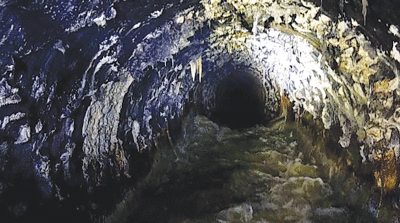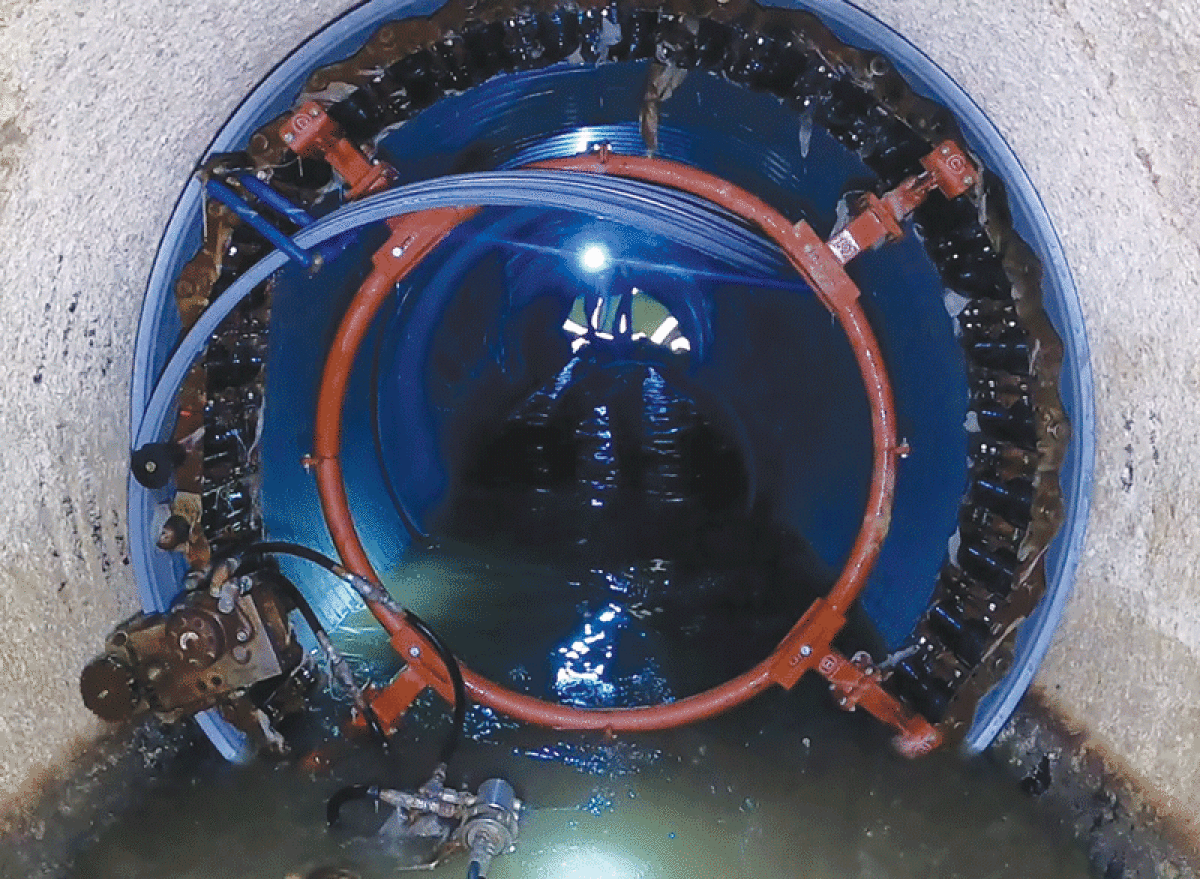
This photo shows the inside of the Garfield Interceptor pipe taken during a 2022 inspection. Chemicals from the fast-flowing sewage corroded the concrete pipe.
Photo provided by Macomb County Public Works Office
MACOMB COUNTY — A new method of drain repair was recently employed by the Macomb County Public Works Office, preventing further damage to a key sewer with minimal interference to locals.
Throughout March and April, contractors for the county have been using a spiral-wound pipe repair process to fix a severely deteriorated pipe at the intersection of 21 Mile and Garfield roads in Macomb Township. The deterioration was caused by a chemical buildup due to the high level of sewage flowing through the pipe, which carries waste away from Shelby Township and Macomb Township.
“All of this agitation is happening, and it creates hydrogen sulfate,” Macomb County Public Works Commissioner Candice Miller said. “It is extremely acidic. Sometimes you’ll walk by a sewer grate and you’ll smell an odor — that’s what you’re smelling.”
Acidic hydrogen sulfate ate away at the concrete pipe, creating a situation that Miller feared could lead to a sinkhole forming if nothing was done to fix it. Normally, the county would use a slip line repair method, but that would require a massive footprint to bring in new pipe and would involve shutting down the intersection during the installation. A slip line repair would also reduce the sewer’s diameter and slow down the flow, in addition to reducing the flow while work was underway.
The Macomb County Public Works Office instead decided to use the spiral-wound pipe repair method, requiring less surface and underground disruptions. In doing so, the project became the first in Michigan to employ the technique.
“It is very much like traditional slip lining, with the exception of we don’t have to dig a large shaft to push pipe into it and we’re utilizing existing structure such as manholes or bolts to access that sewer,” said Anthony Aderhold, of SAK Construction, the contractors performing the work. “The materials for SPR come on large spools, and it’s a PVC strip. We use an advancing machine that winds it into the pipe.”
The advancing machine pulls and snaps the PVC around the existing pipe structure before supports and a structural grout are applied to lock the lining in. The use of only an advancing machine and a pipe spool reduces the surface footprint. The lack of workers going into the pipe allows the sewer to flow as it normally does, and the smooth PVC pipe reduces the friction of the pipe section without significantly changing the diameter.
SPR repairs are not common. Aderhold said SAK only does about two or three repairs of this kind a year.
“They are a niche product,” Aderhold said. “It comes into play when an owner is looking at it and goes, ‘Man, we have very little room for equipment or we can’t bypass it.’ From a cost perspective, it’s very comparable to traditional slip lining where you have a deep trench or a large diameter pipe, but the production rate is quite slower on (traditional slip lining).”
The rehabilitation project cost about $3 million and is expected to last for 50 years. At press time on April 19, grout was being applied to the pipe. The county expects the project to be completed in May.
“We are well on our way to getting this thing complete and hopefully get the traffic cones out of the way,” Miller said.
Repairing the pipe is not the last thing the department plans to do in the 21 Mile and Garfield area. A small air scrubber will be built near the intersection to manage the hydrogen sulfate odors from the sewage. Construction of the scrubber is expected to be completed by late 2025.
 Publication select ▼
Publication select ▼





















